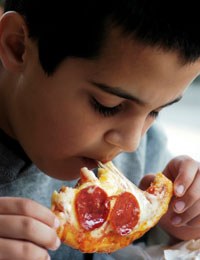
Thirty-one per cent of NZ children aged 5-14 years are overweight or obese. But how do you know if your child is bigger than they should be?
Obesity is a hot issue. Childhood obesity, even more so. But although media attention and public awareness on the issue of childhood obesity is obvious, there seems to be a problem among parents identifying when their child is too heavy for their health. In a recent UK study, 145 children were classified as either overweight or obese. Yet only 6% of these children’s parents described their child as overweight!
It is likely that because so many people – adults and children – are now too heavy, we are ‘de-sensitised’ to fatness. Parents don’t recognise their child is overweight because so many of the child’s peer group are also overweight. It is also likely that as parents we just don’t want to acknowledge that our children are overweight with all the ‘stigmas’ that come with this condition.
So how bad is obesity in our kids, really?
The 2002 National Children’s Nutrition Survey looked at the food and nutrient intakes, eating patterns, physical activity patterns and dental health of 3,276 children aged 5 to 14 years of age. The survey found that approximately a third (31%) of New Zealand children are overweight or obese. About 60% of Pacific Island children and 40% of Maori children are overweight or obese, compared to 24% of other New Zealand children.
How do you know if your child is overweight?
This is a relatively complex question and your best course of action is to see your doctor if you are concerned.
‘Healthy weight ranges’ for children and adolescents are also difficult to determine because children don’t grow out and up at the same rate all the time. Healthy weight ranges change with gender and even each month.
As with adults, a Body Mass Index (BMI) number is calculated, dividing the child’s weight in kilograms by their height in metres squared.
BMI should be used with caution when it comes to children. As with adults, BMI is only a rough guide and more suited to measuring the fatness of populations than individuals. It’s also tricky using BMI to evaluate children because of growth patterns. Between the ages of 1 and 5 years, BMI decreases because children increase in height relatively faster than in weight. After the age of 5 it is the other way around.
BMI alone does not determine whether a child is overweight or obese.
For children and adolescents, BMI is age and gender specific and is often referred to as ‘BMI-for-age’. Age and gender are important factors when calculating a child’s BMI for two reasons:
- The amount of body fat changes with age.
- The amount of body fat differs between boys and girls.
What is BMI?
BMI = Weight (kg)
Height x
height (m)
By plotting an individual BMI value on a BMI chart (gender specific) we can obtain a percentile ranking. This percentile ranking indicates the relative position of a child’s BMI among children of the same age.
- BMI-for-age from the 5th percentile to less than the 85th percentile means a healthy weight.
- BMI-for-age from the 85th percentile to less than the 95th percentile means the child is overweight (approx a BMI of 25+).
- BMI-for-age greater than the 95th percentile means the child is obese (approx a BMI of 30).
Does a ‘fat’ child make a ‘fat’ adult?
Unfortunately the answer is ‘yes’. But… it depends on the age of the child.
Children who are obese between the ages of 2 and 8 years are less likely to become obese as adults, whereas children who are obese between the ages of 10 and 18 years are more likely to continue to be obese adults.
However, as Dr John Birkbeck reported at the recent ‘Childhood Obesity Symposium’, the risk for becoming an obese adult may be just ‘missed’ at younger ages.
Obese adults have a reduced life expectancy of between 7 to 11 years, so it is definitely in the best interest of your child to manage their weight when they are young.
So when should you become concerned?
Recording your child’s development begins at birth when you are given your Well Child Tamariki Ora Health Book (what used to be the old Plunket book). I still have my book from when I was an infant and I value it as a piece of my childhood development history.
The Plunket nurse and the history of height and weight plotted against the percentile charts in the Well Child Book should be a guide as to whether or not your child is heavier than other children of the same age. If your child’s weight is in the upper percentiles, discuss it with the nurse.
After the age of 5 years there is no formal, annual health check for height and weight to assess development. You may have memories of being measured for height occasionally by a parent or caregiver by standing with a ruler on your head against the wall of your house. But that gave no comparison to your peers (just other siblings). There were (and are) no actual, accurate measures made. Ask your GP to make a regular check on your child’s height and weight.
Losing weight is very difficult, even for adults, so the aim is to prevent children getting too fat in the first place. If you are concerned your child is putting on too much weight, it’s important to deal with it at an early stage.
Nobody suddenly becomes obese – it is a gradual process of getting a little bit heavier all the time over a long period of time.
Why are our children getting fatter?
The following behaviours, identified in the NZ Children’s Nutrition Survey, are likely to increase the risk of weight gain – independent of age, gender, ethnicity and socio-economic status:
- Physical inactivity
- Missing breakfast
- Missing lunch
- Buying food to eat at school from the dairy
- Drinking fizzy drinks
- Watching TV
What are the risks of being an obese child?
Being too heavy can cause some serious health problems. Obesity is a very complex condition and will affect the individual (child or adult) medically, emotionally, socially and psychologically.
Complications include:
- Heart-related problems – high blood pressure, high cholesterol
- Type 2 diabetes
- Respiratory problems – asthma, sleep apnoea
- Bone/hip conditions
- Depression and low self-esteem
www.healthyfood.com
















